The Tower in the reign Henry VIII
Many more royal prisoners were to arrive at the Tower under the Tudors, particularly under that most ruthless and tyrannical of monarchs, Henry VIII. He had two of his famous six wives executed on Tower Green, along with many others in this most bloodstained of reigns.
Chapel of St Peter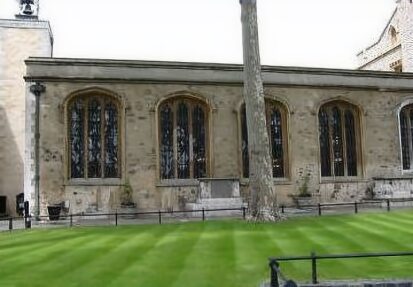
Bishop Fisher and Sir Thomas More, were imprisoned in the Tower by Henry for their refusal to subscribe to the Act of Supremecy, which made the monarch Head of an English Church which was divorced from Rome. The situation had arisen through Henry's desire to divorce his first wife, Catherine of Aragon to enable him to marry Anne Boleyn. The Pope could not grant Henry the required annulment, as Catherine's nephew, Charles V, the powerful Holy Roman Emperor and King of Spain held him in his power. Hailed as Catholic martyrs, they received the support of the Pope, who promised to make Fisher a Cardinal in reward for his heroic stand for the rights of the Church against the formidable monarch's wishes. Enraged and ruthless when opposed, Henry vowed that if a hat arrived to make him a cardinal, the Pope would find Fisher had no head on which to wear it. The aged Bishop stood bravely by his principles. On 17th June, 1535, he was found guilty of treason and sentenced to death.
The brilliant Sir Thomas More, author of 'Eutopia' and Henry's Lord Chancellor and close friend suffered the same fate.
Less than a year passed after More's execution before the fickle Henry tired of Anne Boleyn, the woman he had done so much evil to make his wife and Queen of England. She had not produced the much-desired son and heir she had promised to deliver, only a daughter, considered useless by Henry, the future Elizabeth I and the king's attention's had turned to her Lady-in-Waiting, Jane Seymour. After giving birth to a stillborn son, Anne, who had miscarried of her saviour, was arrested on a concocted charge of adultery and after entering the Tower through Traitor's Gate, was imprisoned in the Queen's House. Ironically, she had spent the night before her coronation there also, when at the peak of her power, such a short while ago.
Traitor's Gate
Many of the sad procession of Tudor prisoners entered the Tower through the notorious Traitor's Gate, The gate was constructed by Edward I, to provide a water gate entrance to the Tower, part of St. Thomas's Tower, built to provide additional accommodation for the royal family.
Traitors Gate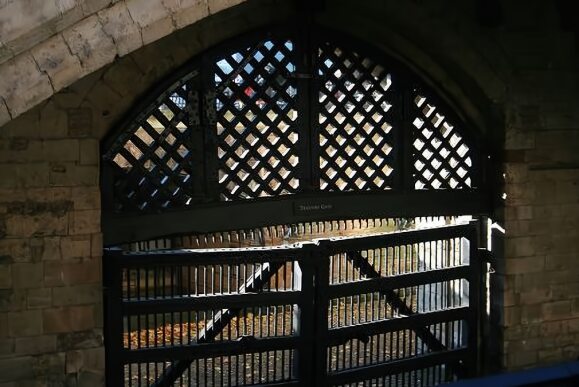
The name Traitor's Gate has been used since the early seventeenth century, prisoners were brought by barge along the River Thames, passing under London Bridge, where the grisly heads of recently executed prisoners were displayed on pikes. Queen Anne Boleyn, Queen Katherine Howard and Anne Boleyn's daughter, the great Elizabeth I, all entered the Tower by Traitor's Gate. The 21-year-old Princess Elizabeth was sent to the Tower on the orders of her half-sister, Mary I. In a terrified state, believing she would never leave the confines of the Tower alive, she sat on a stone by Traitor's Gate in the pouring rain, refusing to enter the gruesome fortress, from which her mother had never emerged.
Anne's trial took place in the medieval Great Hall. Despite the spirited defence of her reputation and rigorous denial of the charges brought against her, which included the ridiculous charge of incest with her brother, she was sentenced, by a jury controlled by Henry, making it a pre-decided issue to be burned or beheaded at the King's pleasure. Her uncle, the Duke of Norfolk presided over the jury, although her father, the self-seeking Thomas Boleyn was excused his duty as a juror.
Deserted by everyone in her dramatic change of fortune, Anne Boleyn met her end as her victims More and Fisher had, with courage. The Queen was executed on Tower Green, Henry thoughtfully brought over a French executioner so that Anne could be beheaded by the sword, not a clumsy axe. Resigned to her death, she was reported to have walked to the scaffold at Tower Green. She completed her speech to the spectators with the cryptic comment that "If any man should meddle with my cause, I pray you to judge the best". It is believed that she presented her case in this manner so that neither her family or her daughter would suffer after her demise.
The executioner was an expert with the sword and had no need for a block. As Anne nervously turned, with bandaged eyes, he took off her head with one sweep that sliced through her neck, her lips were seen to continue to move for a few minutes after. Anne's bloody corpse was hastily contained in an arrow chest and buried in the Chapel of St. Peter ad Vincula, within the Tower. A few day's later, Henry announced his engagement to his new love, Jane Seymour.
Tower Green and the Chapel of St. Peter ad Vincula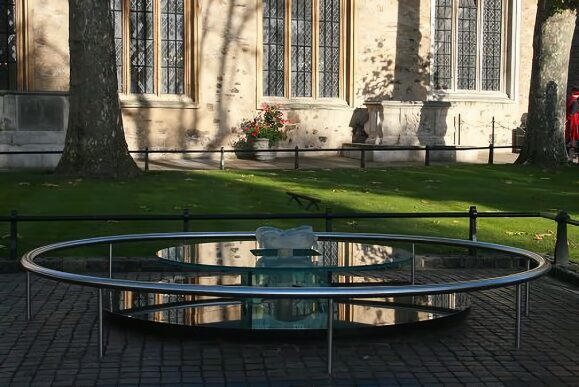
Tower Green
A paved area on Tower Green is marked by a modern memorial to all who were executed there.
A plaque lists the names of all those who were executed on the Green:-
William, Lord Hastings, June, 1483, executed on orders of Richard III
Queen Anne Boleyn, 19 May, 1536
Margaret, Countess of Salisbury, 27 May, 1541
Queen Catherine Howard, 13 Feb, 1542
Jane, Viscountess Rochford, 13 Feb, 1542
Lady Jane Grey, 12 Feb, 1554 executed on orders of Mary I
Robert Devereux, Earl of Essex, 25 Feb, 1601, executed on orders of Elizabeth I
Only a few years later, the fickle wheel of fortune turned full circle and Henry's able, if ruthless administrator, Thomas Cromwell, who had helped engineer the downfall of Anne Boleyn, Thomas More and Bishop Fisher was himself thrown to the wolves by Henry.
Having outlived his usefulness, Cromwell had evoked the King's deadly anger by his part in the otherwise comic affair of Henry's disastrous fourth marriage to that "Great Flanders Mare", Anne of Cleves, whom the King found deeply distasteful. On his marriage morning, Henry miserably declared "If it were not to satisfy my realm and my people, I would not do that which I must do this day for no earthly thing." Anne, wisely complying with all her terrifying spouse's demands, survived. The expendable Cromwell was sent to the block. The Spanish Armoury within the White Tower contains the historic instruments of torture, including the infamous block and axe, upon which so many lost their heads, the axe has been in the Tower since 1687.
Anne Boleyn's ghastly fate was later shared by her young and promiscuous cousin, Catherine Howard, a Catholic, who was manoeuvred by her ambitious uncle the Duke of Norfolk, to became the king's fifth wife, through which the Catholic faction at court hoped to gain power and influence. Henry doted on his teenage bride and instructed the Bishop of Lincoln to give thanks to God for his happiness "after sundry troubles of mind which had happened to him by marriages." Henry's wedded bliss was short-lived, for Catherine, given in her prime to a now vastly obese and rapidly ageing man, cuckolded her spouse, foolishly indulging in affairs with young men of her own age. The Queen's infidelities came to light and determined to pull her down from power, her Protestant enemies pounced.
Charged with adultery and high treason and realizing her horrific fate, the eighteen-year-old Queen lost control and became hysterical. In an appalling and piteous scene, she had to be dragged into the barge which was to conduct her, via the river, to the Tower. As the barge carrying the distraught Catherine passed under Tower Bridge, the decapitated heads of her young lovers, Francis Dereham and Thomas Culpeper, were visible on pikes above her. Following in the footsteps of Anne Boleyn, she entered the Tower by the dreaded Traitor's Gate.
The now megalomaniac Henry complained bitterly that of all the wives he had taken," not one of them had put themselves out to be a comfort" to him! As the day of her execution approached, the highly-strung Catherine struggled to re-gain her composure and begged that her family should not also be punished for her offences.
When informed on 12th February 1542, that she was to die the following day, Catherine practised the macabre act of laying her head upon the block prior to her execution, so that she might die well, as befitted a queen and she succeeded. Catherine died by the axe on Tower Green, displaying more dignity at her end than she had ever done in life. Her Lady-in-Waiting, Jane, Viscountess Rochford, was also sent to the block, for her part in procuring Catherine's lovers. The highly nervous Lady Rochford, in a frantic state, mounted the blood-splattered scaffold immediately after her mistress and was similarly dispatched by the headsman.
With all the executions and murders that have taken place within its walls, the Tower has gained the reputation of being one of the most haunted buildings in England. Sightings have often been reported of the Princes in the Tower who were murdered in the Bloody Tower. They are said to appear dressed in white nightshirts, touchingly holding hands, before fading mysteriously out of sight. One tale, related by two fifteenth-century guards, states that while passing a spiral stone staircase in the Bloody Tower, they saw the shadows of two children gliding down the stairs.
Of all the ghosts said to haunt the Tower, that of the Anne Boleyn has been the most frequently sighted. Her headless body is said to roam in the vicinity of Tower Green and the Chapel of St. Peter ad Vincula. A sentry in 1864 is reported to have seen a headless figure drifting towards him. When his bayonet went straight through the figure, his story went, he fainted from shock. He escaped court-martial for being found asleep on duty when two very good friends verified the story of the apparition!
The aged Margaret, Countess of Salisbury, last of the Plantagenets and the mother of Cardinal Pole, was also executed in the Tower under Henry VIII. Her eldest son, Henry, Lord Montagu, had previously been imprisoned in the Beauchamp Tower and later executed for his Yorkist blood. As Henry's cousin, the Countess was also deemed by the pathologically suspicious King as too near to the throne to be left alive.
Then aged nearly seventy, she was beheaded in a corner of the Tower. Margaret proudly refused to lay her head upon the block, proclaiming herself no traitor. In the hideous scene which followed, her neck and shoulders were hacked at in haphazard fashion by the executioner, as the old lady refused to keep them still. The mangled corpse of the last of the Plantagenets was buried in the Chapel of St. Peter ad Vincula.
The Tower Armouries
Henry VIII held a fascination for armour and amassed a large collection, which was housed at the Tower Armouries. This, the oldest museum in England still exists within the Tower to the present day, where much of Henry's collection can still be viewed.
The Tower Armouries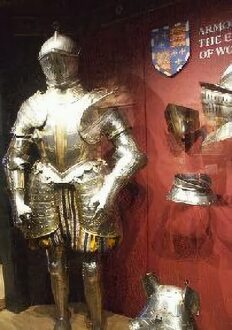
The advancement in size over the years of Henry's suits of armour bear witness to the monarch's rapidly expanding girth. The much smaller armour of Charles I is also on display, along with a vast array of weapons from various historical periods.
Armour and horse armour of Henry VIII, one of many examples on display at the Tower armoury.
Armour of Henry VIII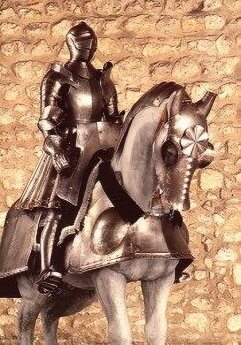
The Tower under the later Tudors
Henry VIII's daughter, Mary I, known as 'Bloody Mary' executed her young cousin and rival, the ill-fated Jane Grey, who had occupied England's throne for nine days under the machinations of her ambitious father-in-law, the Duke of Northumberland. The unfortunate Jane was placed on the throne after the demise of King Edward VI and was little more than the tool of the ambitions of others. Before her own execution on 12th February 1554, Jane watched from her window in the Gentlemen Gaolers Lodgings, as her young husband, Guilford Dudley, walked sobbing from his lodgings in the Beauchamp Tower to be beheaded on Tower Hill. Later that day, the sixteen-year-old Jane was lead out to her death by beheading on the scaffold at Tower Green.
The great Queen Elizabeth I also suffered a term of imprisonment in the Tower by her sister Mary. Suspected of underhand involvement in the Wyatt Rebellion, she was arrested and taken to the Tower. Possessed of a great deal of intelligence and fortitude and a born survivor, Elizabeth ensured nothing could be proved against her. She was housed in the Bell Tower, but was allowed to take exercise by walking along the battlements which adjoined the Beauchamp and Bell Towers, which is still known as Elizabeth's Walk. Finding no evidence of Elizabeth's involvement in the plot, Mary was eventually prevailed upon to release her. Her confinement in the Tower, however, must have been a terrifying experience. The memory of her mother, Anne Boleyn's horrific fate must have loomed large before her.
